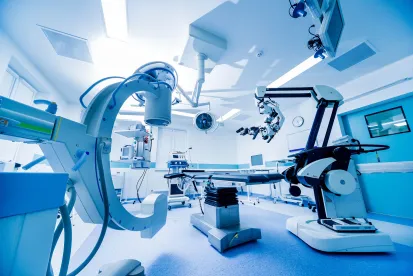On June 22, 2023, the Centers for Medicare & Medicaid Services (CMS) announced its proposed “Transitional Coverage for Technologies” (TCET) pathway—the Biden administration’s highly anticipated take on a mechanism to expedite coverage for certain devices designated by the U.S. Food and Drug Administration (FDA) as breakthrough devices.[1]
As described in the notice with comment period (the “Procedural Notice”), the voluntary TCET pathway aims to streamline efforts between CMS, the FDA, and manufacturers of certain FDA-designated breakthrough devices to more efficiently advance breakthrough devices through the CMS coverage determination processes using a “coverage with evidence development” (CED) approach.
Under the proposed three-phase framework, manufacturers of breakthrough devices accepted into the TCET pathway would enter a period of transitional coverage through a TCET national coverage determination (NCD), during which the device’s manufacturer would be able to generate evidence for CMS to use to determine the breakthrough devices’ post-TCET final coverage status.
Notably, CMS stated that the agency only anticipates accepting five candidates to participate in the TCET pathway each year.[2] Stakeholders must submit comments on the TCET pathway by August 28, 2023.
A Long-Acknowledged Coverage Gap with a Long-Awaited Solution
Created by CMS to support “innovation by providing an efficient, predictable, and transparent coverage review process while developing robust safeguards for the Medicare population,” the proposed TCET pathway can be considered the culmination of long-term federal efforts from both political parties to overcome regulatory gaps that have continually impeded streamlined Medicare coverage of—and beneficiary access to—breakthrough devices.[3] The FDA created the voluntary Breakthrough Devices Program to expedite the development, assessment, and review for premarket approval, 510(k) clearance, and de novo marketing authorization for devices designated as “breakthrough devices” to improve timely access for patients and providers.[4]
Unfortunately, Medicare’s current coverage mechanisms do not reflect alignment with FDA’s efforts and fail to provide the breakthrough device industry with a pathway to coverage with sufficient uniformity and efficiency to expedite beneficiaries’ access to these unique innovations. Among other factors, Medicare NCDs rely heavily on health outcomes data—particularly with regard to Medicare beneficiaries—to determine whether a device would be “reasonable and necessary.”[5] However, devices in earlier stages of the FDA approval process often lack the clinical evidence needed to satisfy the “reasonable and necessary” criteria to justify CMS’s establishment of a national coverage standard. Furthermore, the laborious NCD process can be inefficient and take three months or longer.[6] While beneficiaries could gain coverage to a breakthrough device through a regional Medicare Administrative Contractor’s (MAC’s)[7] individual determination during a claim-by-claim adjudication or through a MAC’s establishment of a jurisdiction-wide local coverage determination (LCD), such coverage pathways still lack the national uniformity needed to ensure all Medicare beneficiaries can receive coverage for—and access to—products in the breakthrough device market.[8]
Policymakers across the federal government from both sides of the aisle have actively sought to establish a solution to address the absence of a clear and timely pathway to breakthrough device coverage. On January 14, 2021, shortly before the presidential transition, the Trump administration finalized a rule to create a Medicare Coverage of Innovative Technology (MCIT) pathway.[9] The Biden administration withdrew the Trump administration’s final rule on November 15, 2021, to address safety concerns.[10] However, as aspects of the Trump administration’s final rule had received bipartisan support, Congress wrote a bipartisan letter to CMS shortly after the rule’s withdrawal urging CMS to develop a similar rule,[11] and stakeholder calls for CMS to address the coverage deficiencies persisted. Congress members introduced bipartisan bills[12] addressing coverage of breakthrough devices, and in February 2023, Senator Mike Crapo (R-ID), ranking member of the Senate Finance Committee, emphasized streamlining breakthrough device coverage as one of his top priorities.[13] In October 2022, following several CMS stakeholder calls on the issue,[14] CMS published a Journal of the American Medical Association (JAMA) article sharing the agency’s principles on coverage for emerging technologies.[15]
An Overview of the Proposed TCET Pathway
An FDA-designated breakthrough device that has been determined to be within a Medicare benefit category, is not already the subject of an existing Medicare NCD, and is not otherwise excluded from coverage through law or regulation may be eligible for the proposed TCET pathway. As discussed in the Procedural Notice, the TCET pathway will consist of three stages: (1) pre-market review, (2) coverage under the TCET pathway, and (3) transition to post-TCET coverage. CMS expects coverage under the TCET pathway to last “only as long as needed to facilitate the timely generation of evidence that can inform patient and clinician decision making,” which CMS anticipates will take three to five years.[16] The following sections summarize the TCET pathway as described in the Procedural Notice.
PHASE 1: Pre-Market Review
During Pre-Market Review, breakthrough device manufacturers would nominate their device for participation in the TCET pathway 12 months prior to the anticipated FDA decision. Most notably, in the Procedural Notice, CMS stated that it expected that the agency would only accept up to five TCET candidates annually. Once CMS evaluates and accepts or rejects a manufacturer’s device for the TCET pathway, CMS will initiate an “Evidence Preview”—a systematic literature review to enable CMS to identify material evidence gaps—to kick off the CED component of the TCET pathway. Manufacturers must submit an evidence development plan (EDP) to sufficiently address any gaps CMS and the Agency for Healthcare Research and Quality identify during the Evidence Preview.
A. Submission of Full Nomination
-
Interested manufacturers to submit a nomination for their device
-
CMS to confirm receipt and may request supplemental information
-
CMS to preliminarily accept or decline a nomination within 30 business days of confirming receipt
B. CMS’ Consideration
-
CMS to offer an initial meeting with the manufacturer
-
CMS to meet with FDA counterparts to review the technology
-
[Optional] CMS may initiate a benefit category review to determine whether the device—if approved—would likely be coverable through one or more benefit categories
C. CMS Notification
-
CMS to notify the manufacturer whether CMS has accepted the nomination
-
For declined nominations, CMS may hold virtual meetings to discuss potential coverage pathways
-
D. Evidence Preview
-
CMS to initiate an Evidence Preview
-
CMS to share the Evidence Preview with the manufacturer and offer a meeting
-
Manufacturers may propose corrections and raise concerns regarding the Evidence Preview
-
CMS to review manufacturer feedback and finalize the Evidence Preview
E. Manufacturer’s Decision to Continue
-
Manufacturer to pursue national coverage under the TCET pathway and submit:
-
A formal NCD letter expressing the manufacturer’s desire for CMS to open a TCET NCD analysis
-
Additional materials the manufacturer believes support the TCET NCD request
-
OR
-
Manufacturer to discontinue the TCET pathway
F. Evidence Development Plan
-
Manufacturer to submit an EDP to address the evidence gaps identified in the Evidence Preview
-
CMS to review Evidence Preview for 30 business days and provide written feedback to the manufacturer
-
CMS to schedule a meeting with the manufacturer to discuss recommendations
-
The manufacturer and CMS may adjust EDP for another 60 business days after the EDP meeting
Ultimately, CMS will condition TCET coverage on the manufacturer satisfying the evidence development requirements specified in the EDP. Notably, in addition to traditional clinical study designs, CMS will permit the use of fit-for-purpose studies that structure the study design, analysis plan, and study data to target specific questions in EDPs. CMS will issue updates to evidence requirements for fit-for-purpose studies through further guidance and rulemaking.
Further, CMS emphasizes that in addition to justifying study outcomes and performance benchmarks during the EDP meeting, manufacturers “should be prepared to demonstrate: (1) a compelling rationale for its EDP; (2) the study design, analysis plan, and data are all fit for purpose; and (3) the study sufficiently addresses threats to internal validity.”[17] CMS will post non-proprietary information contained in EDPs to CMS’ website.
PHASE 2: Coverage Under the TCET Pathway
Once a device accepted into the TCET pathway receives FDA marketing authorization, CMS will initiate the NCD process for Medicare coverage using the standard NCD statutory timeframes.
Additionally, CMS emphasizes that the agency will adhere to statutory NCD requirements with regard to soliciting stakeholder feedback and will strongly consider specific feedback on evidence and suggested approaches from specialty societies and patient advocacy organizations. Notably, to overcome time constraints, CMS encourages such organizations to post additional feedback on the organization’s public website within 90 days of the NCD and to notify CMS of the information.
PHASE 3: Transition to Post-TCET Coverage
Within six months of the EDP review date, CMS plans to conduct an updated evidence review as part of the NCD reconsideration process. Based on CMS’ findings, the agency will propose coverage for the breakthrough device.
TCET vs. MCIT
The Biden administration’s proposed TCET pathway includes components that could represent a significant improvement in streamlining coverage for breakthrough devices and patient safety. Nonetheless, as predicted when analyzing the principles CMS published in JAMA last fall, the TCET pathway presents a far more onerous and narrow framework than its predecessor MCIT pathway finalized during the Trump administration.
Most significantly, unlike the MCIT pathway that would have allowed immediate transitional coverage for breakthrough devices granted FDA market authorization, CMS’s proposal to only allow five devices per year into the TCET pathway fails to create an adequate coverage pathway for breakthrough devices beyond the five actually selected. CMS explained that the limitation stemmed from “CMS resource constraints” and that CMS anticipated receiving fewer than ten nominations per year—despite FDA already designating 64 devices as breakthrough devices in 2023 and having designated 166 breakthrough devices in 2022, 206 in 2021, and 151 in 2020.[18] Further, CMS states “CMS intends to prioritize innovative medical devices that, as determined by CMS, have the potential to benefit the greatest number of individuals with Medicare.”[19] Yet, CMS fails to describe the criteria upon which the agency intends to base its determination. In effect, the combination of the onerous multi-step process proposed for CMS to evaluate nominations and the ambiguous, unspecified criteria upon which CMS may base its determination could deter manufacturers from attempting to participate and particularly inhibit manufacturers of devices that target smaller rare disease populations.
Additionally, the TCET pathway conditions TCET coverage on the breakthrough device manufacturer meeting certain evidence development requirements agreed upon in the EDP. Under the MCIT pathway, CMS would have merely encouraged but not required evidence generation. The following table summarizes additionally differences between the withdrawn MCIT and proposed TCET pathways.
| Trump Administration’s MCIT Pathway – WITHDRAWN | Biden Administration’s TCET Pathway – PROPOSED |
| Pathway Candidates | |
|
· Breakthrough devices granted FDA market authorization Clinical lab diagnostic tests designated as breakthrough devices are eligible |
· CMS expects to allow only five breakthrough devices in the TCET pathway · Diagnostic laboratory tests are ineligible |
| Initiating the Pathway | |
| · Required manufacturers to email CMS of their intention to utilize the MCIT pathway | · Requires manufacturers’ submission of a complete nomination, CMS’s consideration of each submission, an optional meeting with CMS, a meeting between CMS and FDA, and (potentially) a benefit category review |
| Engagement with CMS | |
| · CMS would have coordinated with the manufacturer with the frequency of subsequent engagement “largely driven by whether the manufacturer has questions for CMS, or CMS and FDA”[20] | · CMS-specified engagement points throughout the nomination, Evidence Preview, and EDP processes and throughout the TCET pathway |
| Evidence Generation | |
| · Did not require the manufacturer to develop clinical evidence, but encouraged manufacturers to “develop the clinical evidence base needed for one of the other coverage pathways after the MCIT pathway”[21] | · Conditions TCET coverage on further evidence development as agreed upon by manufacturer and CMS in approved EDP, requires public comment to finalize a TCET NCD, and requires an updated evidence review and an NCD reconsideration after transitional coverage |
| Timing of Transitional Coverage | |
| · Transitional coverage to last four years from the date of FDA market authorization and will last at the manufacturer’s discretion within the four-year timeframe | · Transitional coverage to last as specified in the EDP for the manufacturer to generate sufficient evidence to address gaps in the Evidence Preview |
| Post-Transitional Coverage | |
| At the end of the MCIT pathway, the device would have been subject to: · (1) an NCD with affirmative coverage that may include facility or patient criteria, · (2) a non-coverage NCD, or · (3) MAC discretion (claim-by-claim adjudication or LCD) CMS encouraged manufacturers interested in an NCD to submit an NCD request during the third year of MCIT. |
CMS to initiate an NCD Reconsideration proposing: · an NCD without evidence development requirements, · an NCD with continued evidence development requirements, · a non-coverage NCD, or · permitting local MACs to determine coverage at their discretion. |
Looking Forward
CMS’s TCET proposal coincides with recent increased Congressional scrutiny over other CMS activity involving coverage determinations for life sciences innovations, particularly in the Medicare Part B drug space. In April 2022, CMS announced Medicare would only cover Alzheimer therapies that use the monoclonal antibodies directed against amyloid mechanism upon traditional FDA approval.[22] However, upon FDA’s recent first traditional approval of an Alzheimer drug, CMS introduced an unprecedented new requirement in the drug’s NCD—requiring the providers to submit data to a CMS-facilitated registry to be eligible for payment.[23] In response to these developments and CMS’s proposed TCET pathway, congressmembers have held hearings on CMS’s coverage policies,[24] sought more clarity on the NCD process,[25] and continue to consider other potential legislative options.[26] Additionally, certain life sciences industry stakeholders remain particularly engaged in the Medicare coverage debate and are advocating for lawmakers to address gaps in current proposals and develop coverage solutions for innovations without existing benefit categories, such as digital therapeutics, which would be ineligible for CMS’s proposed TCET pathway.
As evidenced by the long political and regulatory road taken to reach the proposed TCET pathway, breakthrough device manufacturers and other stakeholders with concerns of advancing and expediting patient access to life sciences innovations should take advantage of the opportunity to submit comments to the Procedural Notice by August 28, 2023. CMS will hold a stakeholder call on August 1, 2023, to inform stakeholders of the TCET pathway and to specifically seek feedback on the following:
-
The proposed timeframe for manufacturers to self-nominate for the TCET pathway
-
Whether CMS should finalize its proposal to tie the duration of TCET coverage to the date specified in the EDP
-
The approach for evidence development requirements for second- and third-to-market devices
Additionally, CMS has also proposed the following new guidance documents addressing the agency’s approach to coverage reviews and evidence development:
-
CMS National Coverage Analysis Evidence Review—provides a framework “for more predictable and transparent evidence development”[27]
-
Coverage with Evidence Development—provides a framework for “more predictable and transparent evidence development” [28]
Stakeholders must submit comments to these guidance documents by August 21, 2023. [29]
Hailey Genaw, a Summer Associate (not admitted to the practice of law) in Epstein Becker Green’s Washington, DC, office, contributed to the preparation of this blog post.
Lorrin Melanson, a Summer Associate (not admitted to the practice of law) in Epstein Becker Green’s Washington, DC, office, contributed to the preparation of this blog post.
FOOTNOTES
[1] Transitional Coverage for Emerging Technologies, 88 Fed. Reg. 41,633 (June 27, 2023).
[2] Id. at 41644.
[4] FDA, Breakthrough Devices Program (last updated July 12, 2023).
[5] Set forth in 42 U.S.C. § 1395y(a)(1)(A).
[6] 88 Fed. Reg. at 41635; Joseph Grogan, Medicare Coverage of Innovative Technologies: The U.S. Should Do More to Speed Entry of Breakthrough Devices to Market, Univ. S. Cal. (Sept. 23, 2021) (“It took 67 months for SCULPTRA, a medical device used to help HIV patients, to gain CMS coverage after receiving FDA authorization.”).
[7] CMS, What’s a MAC, Ctr. Medicare and Medicaid Serv., (last updated March 16, 2023).
[8] See Medicare Program; Medicare Coverage of Innovative Technology (MCIT) and Definition of “Reasonable and Necessary,” 86 Fed. Reg. 2,987, 2,990 (Jan. 14, 2021) (commenters noted concerns over “ambiguity and possible inconsistency” with claim-by-claim coverage); 88 Fed. Reg. at 41,635 (noting that LCDs are not binding during the claims adjudication process and only apply in the MAC’s local jurisdiction).
[10] CMS, Press Release, CMS Repeals MCIT/R&N Rule; Will Consider Other Coverage Pathways to Enhance Access to Innovative Medical Devices (Nov. 12, 2021).
[11] Congress, Letter to Administrator Brooks-LaSure (Nov. 23, 2021).
[12] H.R. 1691, 118th Cong. (2023).
[13] U.S. Senate, News Release, Crapo Named Ranking Member of Senate Finance Committee (Feb. 9, 2023).
[14] CMS, CMS National Stakeholder Calls: Listening Session on Temporary Coverage of Emerging Technology on Thursday, February 17, 2022; Listening Session on Transitional Coverage for Emerging Technologies #2 on March 31, 2022.
[15] CMS, A Vision of Medicare Coverage for New and Emerging Technologies; Lee Fleisher & Jonathan Blum, A Vision of Medicare Coverage for New and Emerging Technologies—A Consistent Process to Foster Innovation and Promote Value, JAMA (Oct. 12, 2022).
[16] CMS, Fact Sheet: Notice with Comment – Transitional Coverage for Emerging Technologies (CMS-3421-NC), (Jun. 22, 2023).
[17] 88 Fed. Reg. at 41641.
[18] FDA, Breakthrough Devices Program (July 12, 2023).
[19] 88 Fed. Reg. at 41644.
[20] 86 Fed. Reg. at 2992.
[21] Ibid. at 3002.
[26] H.R.1691 – Ensuring Patient Access to Critical Breakthrough Products Act of 2023
[27] CMS, (PROPOSED) CMS National Coverage Analysis Evidence Review (June 22, 2023).
[28] CMS, (PROPOSED) Coverage with Evidence Development (June 22, 2023)
[29] 88 Fed. Reg. at 41633.





 />i
/>i


